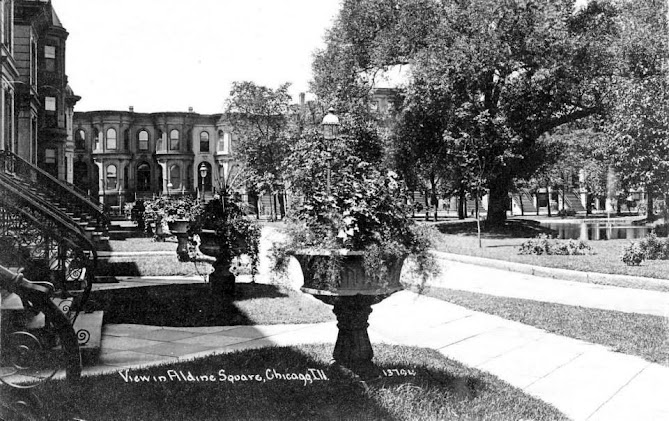Aldine Square was built on untouched prairie land on the South Side of Chicago.
Since the onset of the 20th century, Aldine Square has been one of the city's most fashionable neighborhoods for a few decades. Its big brick and limestone townhomes surrounded a wooded park with a lake and footbridge.
Built in 1874 between 37th Place and 38th Street, bounded by Vincennes Avenue (entrance) to the east and Eden Avenue (entrance) - no longer exists) to the west.
Aldine Square was where judges, attorneys, and folk in society lived. In 1877, the Chicago Tribune called it "the most charming of all the beautiful places of residence in the city." It consisted of 42 houses built of brick and limestone that surrounded a park with a pond and was initially paved with Belgian Woodblock. Homes in the neighborhood carried an "Aldine Square" address.
 |
| Looking westward shows the Aldine Square main entrance on Vincennes, marked by two enormous stone pylons. Ragtime giant Jelly Roll Morton lived at 545 Aldine in 1918. |
Towards the end-of-life of Aldine Square, near the Eden Street entrance, was a dumping ground over which a sign read, "No Dumping Here."
But by 1938, Aldine Square was gone, razed to build the now-demolished Ida B. Wells public housing project, and is all but forgotten. Fortunately, just before Aldine Square was demolished, the federal government sent photographers Joseph Hill and Robert Tufts to document the site. Their photographs, taken between 1934 and 1936, are among the few visual records of this spectacular Place that looked impressive even in its final days.
So, what happened to Aldine Square? When black migrants from the South began settling in the Chicago area beginning in the 1920s, the white residents of Aldine Square and the surrounding neighborhoods moved away.
The onset of the Great Depression in 1929 further exacerbated economic conditions, and the area quickly became slum housing.
 |
| Here you can tell the still-stately homes have seen better days. The simple wooden footbridge in the foreground replaced the more elaborate iron and wood original one. |
The Chicago Tribune documented this in a 1929 story about a neighborhood reunion held by Aldine Square's original families. The article said the gathering was held at a downtown hotel by residents who "moved away from the path of the advancing Negro district."
That Negro district had some of the most substandard housing in the city, and the big, new, modern Ida B. Wells public housing project was supposed to fix those ills. Aldine Square, which occupied a small portion of the future public housing site, was in the path of progress.
Ironically, the Ida B. Wells homes have been demolished and replaced by upscale housing in the newly gentrified neighborhood.
Compiled by Dr. Neil Gale, Ph.D.








Good article, Neil. I knew about Aldine but had never seen a single photo. This development reminds me of Auburn Park down by 78th and Normal, with its lagoon; and of Alta Vista Terrace up just north of Wrigley Field, with its rows of early 20th century townhomes.
ReplyDeleteWell researched account that documents how these high society folks became "Slum Lords" and failed to maintain their properties AFTER they move out of the "Negro District." Driven by greed, these high echelon former residents created the tenament "substandard housing" by packing as many people in rental units as they could.
ReplyDeleteI never knew about this community. Thank you for this historical record.
ReplyDelete